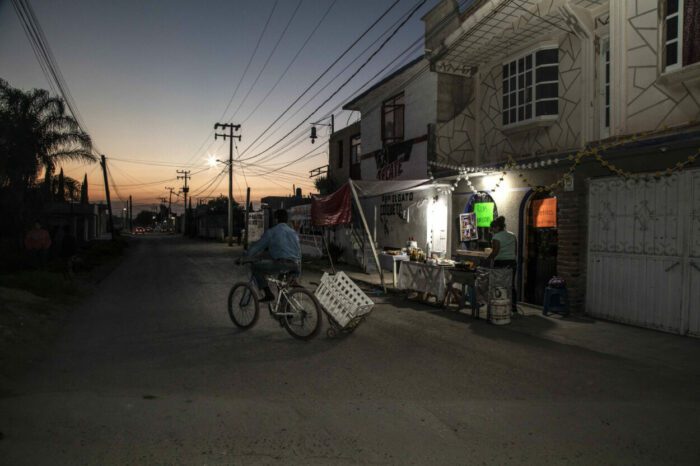The filmmaker is not the subject. A documentary is not acted. At least that’s the way things usually work. But not in the brilliantly empathetic and boundary-busting Mexican Dream, a true and touching tale of a woman’s midlife crisis of sorts, told together by filmmaker Laura Plancarte and her subject and co-writer María Magdalena. The story of the film’s making, conceived of during the Coronavirus pandemic but remade, essentially, in its wake, is as fascinating as the subject herself, a proud and fierce Latin American woman fighting for her relationships with her children as well as her new partner and her prospects for fertility. As experimental and innovative as its form may be, Mexican Dream is first and foremost a tale of the few choices an impoverished woman at midlife faces—presented first-hand with an earnest urgency and authenticity.
Magdalena, or Malena, or Male (pronounced MAH-lay), as she is most often called in the film, has had three children with her first husband, but his abuse forced her to leave for Mexico City and take up work as a domestic for an upper-class household. The move cost her the custody of her three teenage children, who regard her today with a range of emotions: one son understands and loves her, her daughter is outright hostile in her rejection. In Mexico City Male has set up a household with a new man, one who seems loving but expresses little interest in co-raising Male’s teens.

Male’s “Mexican Dream,” as it were, is to live, in harmony with her new partner, a new infant (or two) with him, and her children from her prior marriage, all together under one roof. Ideally too she could quit work as a domestic and set up a small shop of her own, where she can sell mementos and curios and earn at least a modest income. No element of Male’s dream will come easily, though. For one, to avoid having more children with her abusive ex-husband, she’d had her tubes tied. She’ll need in vitro fertilization treatment—not only expensive and risky, but controversial in her culture—if she is to have a second chance at motherhood. And no one seems fully on board: her children question her decisions, her ex-husband continues to try to control her, and her new partner threatens to leave her if the IVF fails.
The complexities of Male’s life intersect in ways that could easily make for a fine fiction film. Yet hers are real-life crises, and the impact of a teen daughter’s venomous voicemail or a romantic partner’s callow rejection are difficult to watch unfold. Male—María Magdalena—is a real woman whose life situation has hemmed her in with few choices and fewer resources. That she can can remain resilient in the face of these adversities—and still pursue her dreams—is admirable indeed.
As one watches Mexican Dream, though, one can not help but wonder: what, exactly, are we seeing? The film is crafted with the impeccable cinematography of the finest fiction films: gestures and reactions are captured in close-up, shallow depth-of-field with chiaroscuro lighting and evocative color; the editing subtly, almost impossibly captures every nuance of detail in ad hoc conversation; Male and her interlocutors speak (and sometimes stare and chew in abject stony silence) at the peak of emotion, apparently oblivious to the presence of camera and crew. Can a documentary work this way?

Yes—and no. What one sees onscreen in Mexican Dream may well be documentary in nature but not necessarily “a” documentary in the traditional sense of observed real-life footage. (Long ago, scholar Richard Barsam proposed the descriptor nonfiction for the looser, more inclusive set of films, certainly including ones like Mexican Dream, that serve the same functions as documentaries but do not necessarily operate as documentaries.) During the pandemic’s early lockdowns, director/co-writer Plancarte sent Magdalena an iPhone and asked her to document her own journey to regaining custody of her teenage children and becoming a parent once again. When the nature of the Coronavirus changed and lockdowns lifted, so too did Plancarte and Magdalena’s working relationship, which became even more collaborative and creative.
Together, the two scripted Male’s journey and later shot it, with all the deliberative, planned production of a feature fiction film. Doing so allowed Magdalena to protect her own children’s privacy—their lives already disrupted by upheaval—and give her, as the subject, even more control over her own story. As a consequence, rather than being, simply, as is the case in most documentaries, filmmaker and subject, the two women, Plancarte and Magdalena, became co-equal collaborators, each of them bringing their own talents and perspectives to the story of Male’s journey.
The result, even as it practically defies easy categorization—most documentaries do not consist exclusively of what is normally called reenactment, and most scripted fiction films do not feature the subject/co-writer as a lead actor—makes all kinds of sense. The cinematic approach to depicting Male’s journey is impeccable, credit to Plancarte and cinematographer Franklin Dow. The result defies stereotypes of Latin American women and challenges dominant narratives about poverty. Male, though she faces expectations from friends, family, and others that contradict each other, is brave enough to seek her own happiness.
Ever since and even before the Italian Neorealism of the 1940s, filmmakers have cast, for all kinds of reasons, non-professional actors in supporting and lead roles. For Plancarte, the professional filmmaker, to trust Magdalena not only to co-script but to perform, on camera, as herself, even at moments of such palpable trauma that could make a Douglas Sirk cringe, is an investment that pays off: it may sound odd to say so, but Magdalena is utterly convincing and engaging as Male, as herself, from the first moments of Mexican Dream to the last, in an authentic and rich performance.
For an academic like me, it’s easy to get caught up in the ethics and aesthetics of Mexican Dream‘s unique and boundary-breaking approach. What Plancarte and Magdalena have created together is, in its hybrid, co-conspiratorial method, a film that challenges existing hierarchies and definitions we associate with the very form of documentary. But at the same time, let’s never lose sight of the story it tells, that of a memorable woman who chafes against social constraints, fights for the love of her children, and seeks a second chance when all around her, others attempt to define who she is and how she should live—and love.




